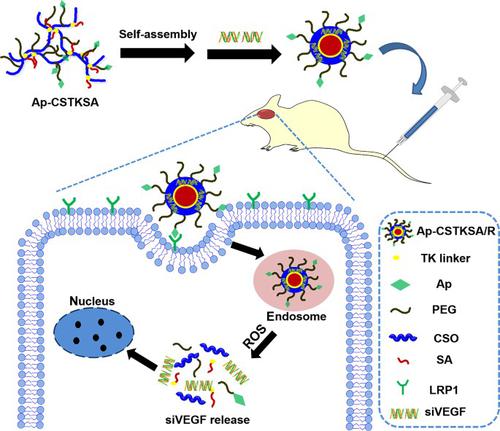Nano Research ( IF 9.5 ) Pub Date : 2021-08-04 , DOI: 10.1007/s12274-021-3686-3 Lijuan Wen 1, 2, 3 , Yu Peng 1 , Shiying He 1 , Ruiwen Xiong 1 , Longping Wu 1 , Kai Wang 2 , Fuqiang Hu 2 , Fengtian Zhang 4, 5 , Zhihua Huang 3

|
Glioblastoma (GBM) is one of the malignant brain tumors with high mortality and no curative treatments. Abnormally elevated vascular endothelial growth factor (VEGF) in GBM seriously disrupts the blood brain barrier (BBB) with an increased permeability, resulting in poor outcome and prognosis. RNAi interference has shown strong potential to inhibit VEGF expression, thus it is necessary to development an effective and safe gene delivery system possessing the ability to cross the BBB and target GBM cells. This study aims to explore the anti-GBM effect of angiopep-2 (Ap) peptide modified reactive oxygen species (ROS) cleavable thioketal (TK) linked glycolipid-like nanocarrier (CSTKSA) delivering anti-VEGF siRNA (R), termed as Ap-CSTKSA/R complexes. Ap functionalized modification produced an enhanced cellular uptake and a stronger bio-distribution of Ap-CSTKSA/R complexes in U87 MG cells and brain tumor tissues, respectively. Ap-CSTKSA/R complexes exhibited great superiority in GBM growth inhibition and finally translated into the longest survival period mainly via receptor-mediated targeting delivery, VEGF gene silencing accompanied with remarkable angiogenesis inhibition, and suppressed expression of caveolin-1 which is involved in BBB functional regulation in the occurrence and treatment of GBM. The study indicated that Ap functionalization on ROS-responsive glycolipid-like copolymer exhibits a promising and effective gene delivery platform for GBM targeted treatment.
中文翻译:

通过纳米结构的 ROS 反应性糖脂样共聚物包裹 siVEGF 调节病理性 BBB 修复,用于胶质母细胞瘤靶向治疗
胶质母细胞瘤(GBM)是恶性脑肿瘤之一,死亡率高且无根治性治疗方法。GBM中异常升高的血管内皮生长因子(VEGF)严重破坏血脑屏障(BBB),通透性增加,导致预后和预后不良。RNAi 干扰已显示出抑制 VEGF 表达的强大潜力,因此有必要开发一种有效且安全的基因传递系统,该系统具有穿越 BBB 和靶向 GBM 细胞的能力。本研究旨在探讨 angiopep-2 (Ap) 肽修饰的活性氧 (ROS) 可裂解硫缩酮 (TK) 连接的糖脂样纳米载体 (CSTKSA) 的抗 GBM 效应,该载体被称为 Ap -CSTKSA/R 复合物。Ap 功能化修饰分别在 U87 MG 细胞和脑肿瘤组织中产生增强的细胞摄取和 Ap-CSTKSA/R 复合物更强的生物分布。Ap-CSTKSA/R 复合物在抑制 GBM 生长方面表现出极大的优势,最终主要通过受体介导的靶向递送、VEGF 基因沉默伴随显着的血管生成抑制和抑制参与 BBB 的caveolin-1 的表达转化为最长的存活期GBM 发生和治疗中的功能调节。该研究表明,ROS 响应性糖脂样共聚物上的 Ap 功能化为 GBM 靶向治疗提供了一个有前途且有效的基因递送平台。Ap-CSTKSA/R 复合物在抑制 GBM 生长方面表现出极大的优势,最终主要通过受体介导的靶向递送、VEGF 基因沉默伴随显着的血管生成抑制和抑制参与 BBB 的caveolin-1 的表达转化为最长的存活期GBM 发生和治疗中的功能调节。该研究表明,ROS 响应性糖脂样共聚物上的 Ap 功能化为 GBM 靶向治疗提供了一个有前途且有效的基因递送平台。Ap-CSTKSA/R 复合物在抑制 GBM 生长方面表现出极大的优势,最终主要通过受体介导的靶向递送、VEGF 基因沉默伴随显着的血管生成抑制和抑制参与 BBB 的caveolin-1 的表达转化为最长的存活期GBM 发生和治疗中的功能调节。该研究表明,ROS 响应性糖脂样共聚物上的 Ap 功能化为 GBM 靶向治疗提供了一个有前途且有效的基因递送平台。抑制参与 BBB 功能调节的caveolin-1 的表达在GBM 的发生和治疗中。该研究表明,ROS 响应性糖脂样共聚物上的 Ap 功能化为 GBM 靶向治疗提供了一个有前途且有效的基因递送平台。抑制参与 BBB 功能调节的caveolin-1 的表达在GBM 的发生和治疗中。该研究表明,ROS 响应性糖脂样共聚物上的 Ap 功能化为 GBM 靶向治疗提供了一个有前途且有效的基因递送平台。











































 京公网安备 11010802027423号
京公网安备 11010802027423号